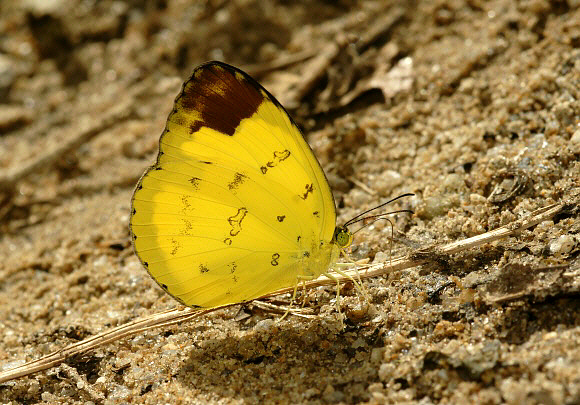
Introduction
The Grass Yellows are all fairly small butterflies, readily recognized by their bright yellow wings and their habit of gathering in small groups on patches of damp sand or soil. Despite their name, none of their caterpillars feed on grasses – the name is derived from the fact that most species are found in disturbed grassy habitats.
Grass Yellows are among the most familiar of tropical butterflies, with a total of 70 known species worldwide, of which 36 are found in the Neotropical region, 13 in North America ( including Mexico ), 10 in Africa, 25 in the Oriental region and 10 in Australia / Papua New Guinea. Many of the species are migratory in behavior, with the ranges of several such as hecabe overlapping into in 2 or more of the zoogeographical regions.
There are 9 species in peninsular Malaysia, most of which also occur in neighboring Thailand, and on Borneo and Sumatra. The commonest member of the genus is hecabe, but none except senna are rare, although ada, andersonii, brigitta and tilaha tend to be localized in distribution.
Eurema simulatrix is found in Sikkim, Myanmar, Thailand, Laos, West Malaysia, Singapore, Palawan & Mindanao ( Philippines ), Sumatra, Sabah, Brunei, Sarawak, Kalimantan, Sulawesi, Java and on many of the smaller islands in the region.
Habitats
This species is found in secondary or disturbed habitats including forest clearings, along roadsides and riverbanks, and in parks and gardens at elevations between 0-800m.
Lifecycle
The lifecycle appears to be unrecorded, but it is possible to make educated guesses:
The eggs of Eurema species are always spindle-shaped, and pale yellow or straw colored when first laid, changing to a darker shade before hatching. They are laid singly on the upperside of leaves of the food plants.
The food plants of simulatrix are not recorded. Other Oriental Eurema species are known to feed on Caesalpinia, Cassia, ( Caesalpiniaceae ), Pithecellobium ( Mimosaceae ) and Wagatea ( Fabaceae ).
The caterpillars of Eurema species when first hatched are typically green, cylindrical, and covered in tiny tubercules from each of which arises a single long stiff hair. In later instars the hairs ( setae ) become progressively shorter. The fully grown larva in most Eurema species is dull green with a thin dark dorsal stripe, and a broader cream lateral stripe below the spiracles. Each segment of the body is ribbed vertically, and covered in small tubercules, giving it a rough textured appearance.
The chrysalis will be shaped similarly to that of other members of the Coliadinae – slim, sharply pointed at head and tail, and with prominent wing cases. It is likely to be pale green or straw colored, and probably marked with fine blackish speckling.
Adult behavior
Males congregate to imbibe mineralized moisture from damp sandbanks, usually in groups of less than a dozen, unlike hecabe which gathers in scores. E. simulatrix also tends to be found in mixed aggregations which often include other Pierines such as Appias, Papilionids such as Pathysa and Graphium, and Nymphalids such as Vindula.
Females are more discreet in behavior, normally being seen singly when nectaring. They will visit many different flowers, but generally seem to prefer smaller less conspicuous species.
